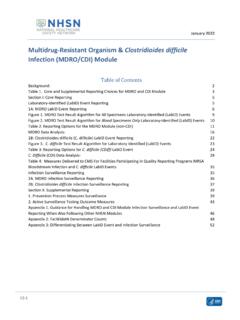Transcription of CLABSI in Non-Intensive Care Unit (non-ICU) Settings
1 Central Line-Associated Bloodstream Infections ( CLABSI ) in Non-Intensive care unit (non-ICU) Settings ToolkitActivity C: ELC prevention CollaborativesDraft - 1/22111/09 ---Disclaimer: The findings and conclusions in this presentation are those of the authors and do not necessarily represent the official position of the Centers for disease control and Kallen, MD, MPH and Priti Patel, MD, MPHD ivision of Healthcare Quality PromotionCenters for disease control and PreventionOutline Background Impact HHS prevention Targets Pathogenesis Epidemiology prevention Strategies Core Supplemental Measurement Process Outcome Tools for Implementation/Resources/ReferencesBackg round.
2 Impact Bloodstream infections (BSIs) are a major cause of healthcare-associated morbidity and mortality Up to 35% attributable mortality BSI leads to excess hospital length of stay of 24 days Central Line (CL) use a major risk factor for BSI More than 250,000 central line-associated BSIs (CLABSIs) in US yearly Rates of CLABSI appear to vary by type of catheterPittet et al. JAMA 1994; 271 et al. Public Health Reports 2007;122 :HHS prevention Targets prevention of CLABSIs in intensive care Units (ICUs) and other locations have 2 associated goals in HHS HAI prevention Plan:-Reduce CLABSIs by 50% -100% adherence with CL insertion practices in non-emergent situationsBackground: ImpactOutside the ICU Most work aimed at reducing CLABSIs in the hospital has been done in ICUs Many CLs are found outside ICUs In one study 55% of ICU patients had CL.
3 24% of non-ICU patients had CL However, as more patients are located outside of the ICU, 70% of hospitalized patients with CLs were outside the ICUC limo et al. ICHE 2003; 24 : ImpactCLABSI Rates CLABSI rates outside ICUs may be similar to rates of these infections in ICUs Although data are sparse, in one study CLABSI rates were: per 1,000 catheter-days in 4 inpatient wards per 1,000 catheter-days for medical ICUM arschall et al. Infect control Hospital Epidemiol 2007;28 : ImpactNational Healthcare Safety Network (NHSN) CLABSI Rates From 2006 2008 NHSN report, pooled mean CLABSI rates were: Medical-Surgical ICUs = to per 1,000 catheter-days Medical-Surgical wards = per 1,000 catheter-daysEdwards JR, et al.
4 Am J Infect control 2009;37 : ImpactCLABSI in Outpatient Settings A number of patient groups may have long-term CLs as outpatients Hemodialysis Malignancy Gastrointestinal tract disorders Pulmonary hypertension Rates of CLABSI may be as high as those seen in ICUs In hemodialysis - 1 to 4 per 1,000 catheter-daysBackground: PathogenesisCLABSIMore Common Mechanisms1. Pathogen migration along external surface- more common early (< 7days)2. Hub contamination with intraluminal colonization-more common >10 daysLess Common Mechanisms1.
5 Hematogenousseeding from another source2. Contaminated infusatesHICPAC. Guideline for prevention of Intravascular Device-Related Infections. 1996 Hub ContaminationContaminated InfusateHematogenous spreadExtraluminal ContaminationHealthcare Personnel Hand ContaminationContamination of insertion Mean CLABSI Rate per 1,000 Central Line Days or %MRSA*No ** **P= **P< : EpidemiologyALL ICU TYPES: Rates of Methicillin-Resistant and Methicillin-Susceptible Staphylococcus aureusCLABSIs United States, 1997-2007 Burton et al.
6 JAMA 2009; 301 CLABSIMSSA CLABSIAre CLABSI Rates falling?Data from NHSN for ICUs suggest rates of MRSA and MSSA central line-associated BSIs are falling in the : EpidemiologyModifiable Risk FactorsCharacteristicRisk Factor HierarchyInsertion circumstancesEmergency > electiveSkill of inserterGeneral > specializedInsertion siteFemoral > subclavianSkin antisepsis70% alcohol, 10% povidone-iodine > 2% chlorhexidineCatheter lumensMultilumen > single lumenDuration of catheter useLonger duration of use greater riskBarrier precautions Submaximal > maximalBackground.
7 prevention StrategiesInterventions Pittsburgh Regional Health Initiative Decrease in CLABSIs in 66 ICUs (68% decrease) Interventions Promotion of best practices Maximal barrier precautions Use of chlorhexidine for skin cleansing prior to insertion Avoidance of femoral site for CL Use of recommended insertion-site dressing practices Removal of CL when no longer needed Educational module about BSI prevention Engagement of leadership and clinicians Standard tools for recording adherence to best practices Standardizing catheter insertion kits Measurement of CLABSI and reporting of rates back to facilitiesCDC.
8 MMWR 2005;54 : prevention StrategiesInterventions Michigan Keystone Project Decrease in CLABSI in 103 ICUs in Michigan (66% reduction) Basic interventions: Hand hygiene Full barrier precautions during CL insertion Skin cleansing with chlorhexidine Avoiding femoral site Removing unnecessary catheters Use of insertion checklist Promotion of safety culturePronovost et al. NEJM 2006;355 : On the CUSP: Stop BSI project This national program is a collaboration between Health Research and Educational Trust Johns Hopkins University Quality and Safety Research Group Michigan Health and Hospital Association Keystone center for Patient Safety and Quality Builds on successes in Michigan Keystone project CLABSI prevention bundle Collaborative model Promotion of safety culture Hospitals in all 50 states, the District of Columbia.
9 And Puerto Rico are eligible to participatePrevention Strategies Core Strategies High levels of scientific evidence Demonstrated feasibility Supplemental Strategies Some scientific evidence Variable levels of feasibility*The Collaborative should at a minimum include core prevention strategies. Supplemental prevention strategies also may be used. Most core and supplemental strategies are based on HICPAC guidelines. Strategies that are not included in HICPAC guidelines will be noted by an asterisk (*) after the strategy. HICPAC guidelines may be found at Strategies: Core Removing unnecessary CL Following proper insertion practices Facilitating proper insertion practices* Complying with hand hygiene recommendations Adequate skin antisepsis Choosing proper CL insertion sites Performing adequate hub/access port disinfection Providing education on CL maintenance and insertion* Not part of 2002 HICPAC Guidelines for the prevention of Intravascular Catheter-Related InfectionsPrevention Strategies.
10 CoreRemoving Unnecessary CL In one study, 9% of CLs outside of ICU deemed inappropriate Perform daily assessment of the need for the CL and promptly discontinue CLs that are no longer required Nursing staff should be encouraged to notify physicians of CLs that are unnecessary Use peripheral catheters instead These generally have lower rates of BSIs than CLTrick et al. Infect control Hospital Epidemiol 2004;25 Strategies: CoreProper Insertion Practices Ensure utilization of insertion bundle: Chlorhexidine for skin antisepsis Maximal sterile barrier precautions ( , mask, cap [ , similar to those worn in the ], gown, sterile gloves, and large sterile drape) Hand hygiene Many CLs in patients on non-ICU hospital wards are placed outside those wards (Emergency room, ICU, Operating room, or Pre-operative areas) In one study, 49% of CLs were present on admission to the ward.












